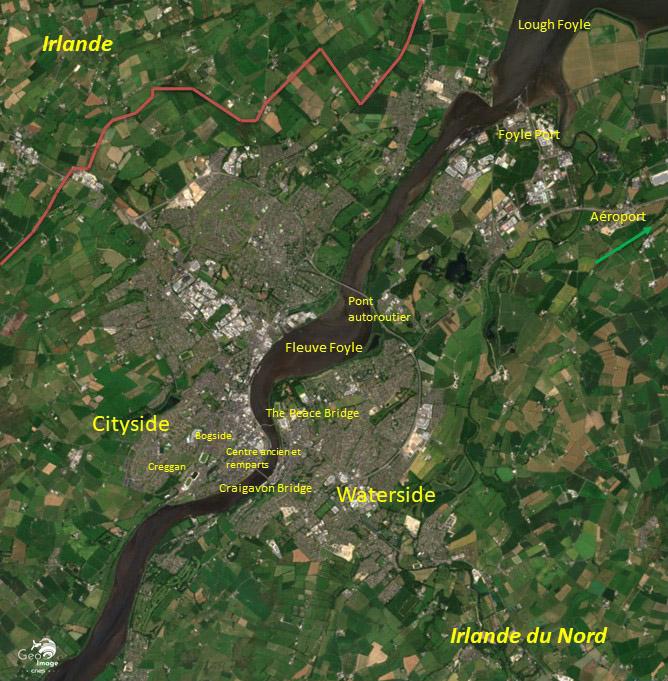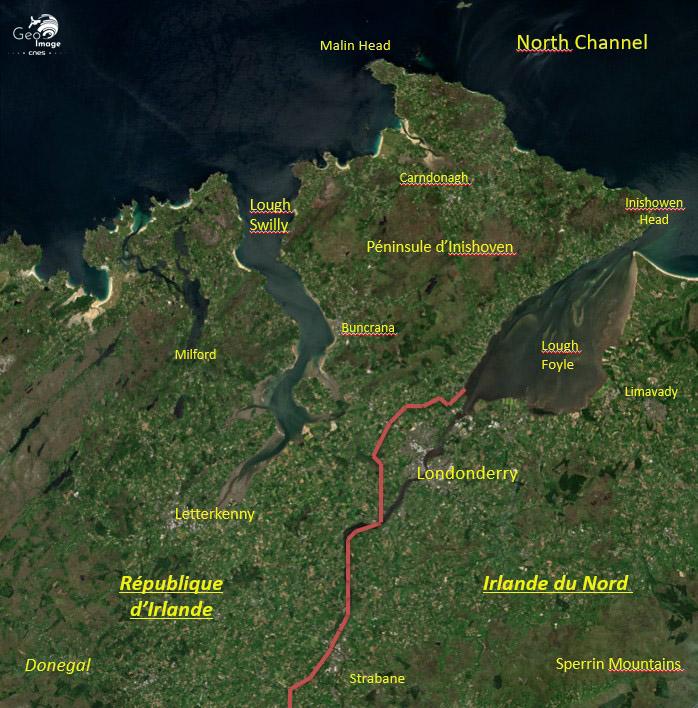Londonderry is located in the north-west of the Isle of Ireland, on the southern extremity of the vast Lough Foyle Bay. It is also very close to the border between the Republic of Ireland and Northern Ireland. Londonderry is situated in a very rural and isolated region. The city and its port play a central role in the economy of the region, as far as neighbouring County Donegal in the Republic of Ireland. More than twenty years after the beginning of the peace process in Northern Ireland, Northern Irish society is a post-conflict society that is still deeply marked by intercommunity tensions, which continue to take place in Londonderry, as everywhere else in Northern Ireland. The way Brexit is going to restructure the place and role of the border is bound to have major urban, social and (geo)political consequences in Londonderry.

Image information
This image was taken by the Sentinel 2A satellite on June 28, 2019. It is a natural color image with native resolution at 10m.
General image without geographical landmarks
Contains information © COPERNICUS SENTINEL 2019, all rights reserved.
General presentation of the image
The city of Londonderry and its region: divided and organised by the Irish border in mutations
A city located in a natural shelter on the extremity of Lough Foyle
As the picture shows, Londonderry is situated on the extremity of a vast bay called Lough Foyle. The site is a classic estuary bottom and ford site with a bridge dominated and controlled on the left bank by a fortified medieval town. In Londonderry, there are only three bridges to cross the River Foyle. The wide and straight Craigavon Bridge is actually the only bridge to connect the two oldest parts of the city. The river acts as a real urban, social, economic and religious divide between the two banks of the River Foyle.
Londonderry is the largest city in the Derry City and Strabane District Council, one of 11 local authorities in Northern Ireland. It is the fourth largest city on the island of Ireland, and the second largest city in Northern Ireland, after Belfast. The population of the Derry City and Strabane District Council is 150,500, that is 8% of the total population in Northern Ireland (1,870 million). 73% of the district's population live in Londonderry (110,200 inhabitants). The population growth in the region over the past ten years has been low, but has been positive (1.6%).
Londonderry is located in a rural and agricultural area which is marked by the fragmentation of cultivated land and farms, 88% of which are very small and small. Agricultural production employs 3,500 workers.
A city historically divided by the River Foyle
The walled medieval centre is located on the left bank of the river. The fortification of central Londonderry dates back to the Plantation period in Ulster by the English from 1608 on. The establishment of a Protestant community in Derry was organised by the city of London, hence the evolution of Derry’s name into Londonderry. The walls were built between 1613 and 1618. They enabled the city to withstand many sieges, including the 105 days of the 1689 siege, when the Protestant community was successfully entrenched within the city walls to resist the troops of Catholic King James II.
The geography of Londonderry has allowed a deeply marked separation/ segregation between the Catholic and Protestant communities to settle. The River Foyle acts as a real religious and community divide. Although community relations have considerably improved in Londonderry since the end of the Troubles in 1998, the city is still divided today and displays of religious intolerance have not disappeared.
On the left bank of the river - called Cityside -, next to the medieval centre, the population is overwhelmingly Catholic. That is where the Bogside area is located, where the bloody intervention of the British army took place on Sunday January 31, 1972. On the other side of the Foyle, on the right bank – called Waterside -, the distribution of the population between Catholics and Protestants is more or less evenly-balanced. However, this is the part of the city where the vast majority of Protestants resides.
It was in particular in the 1970s and 1980s – when the intercommunity tensions called the Troubles were at their height - that the demography of the city profoundly changed towards radical segregation. The Protestant population of Londonderry fell drastically during this period (-31% between 1971 and 1991)- although the trend had started in the 1920s. At the same time, 83% of the Protestants living in the Cityside left this part of the city. Most of them left the city and the region, while the rest moved to Waterside on the right bank of the Foyle where commercial and commercial spaces developed.
At the same time, the Catholic population of Londonderry was increasing by 36% and settled in the vacant areas in and around the old town. Londonderry then became one of the cities in Northern Ireland where spatial segregation between Catholics and Protestants became the most acute.
There are multiple and complex reasons for this spatial segregation. Despite examples of regular intercommunity social events taking place in Londonderry before the Troubles, the divisions were already present. The possible reasons for the Protestant exodus from the old areas of Londonderry may lie in urban renewal operations, the evolution of the housing market, the deterioration of housing and the displays of religious intolerance that generated violence, intimidation and fear. Economic decline was yet another major reason. However, this is a particularly sensitive issue, which is still debated today.
In any case, this reality was reinforced by the geographical divide of the city by the River Foyle into two very distinct parts connected by its one and only bridge - Craigavon Bridge. For a very long time, Craigavon Bridge was actually the only link between the two banks of the Foyle.
The situation has become more stable, however. It seems that the Protestant community has started to re-engage with the shopping areas located within Londonderry’s Cityside since the end of the 2010s owing to the decrease of intercommunity violence, 20 years after the beginning of the peace process. Urban development and geopolitical changes have also led to the creation of two other emblematic bridges which facilitate exchanges between the two communities.
A second bridge called Foyle Bridge came into service in 1984. It is located on the A515, the city’s only bypass. The A515 is a major link between the two banks of the River Foyle, their respective industrial zones, the port and the airport. It is a major road, from an economic and symbolic point of view, as it connects Donegal, in the Republic of Ireland, to Northern Ireland. Without such a road, Donegal which would be very isolated. Under the Good Friday Agreements of 1998 which removed the border between Northern Ireland and the Republic of Ireland, there is no physical border infrastructure on the A515.
Finally, a third bridge is much more recent. It is the Peace Bridge, whose characteristically curved shape makes it easily recognisable. It is a cycle and foot bridge which was inaugurated in June 2011 and whose construction was funded by the European Union PEACE III programme. It was built to enable people to have access to a new mixed-use urban development located across the river from the historic city centre. It was named the Peace Bridge to symbolise the creation of a bond between historically divided communities on either side of the river. Its 310-metre long self-anchored curved suspended structure quickly became a landmark for the city and is an iconic achievement in post-conflict Northern Ireland.
An economic, industrial and employment centre supported by port functions
As the picture shows, at the entrance of the Foyle estuary, on the right bank, lies the port of Londonderry, or Foyle Port. It is an autonomous port which does not depend on any state agency. Originally located in the heart of the city of Londonderry, it was relocated in 1993 to its current location in Lisahally, where the waters are deep enough to accommodate ships with a capacity of up to 65,000 tonnes and measuring up to 215m.
Since the 18th century, its location in the north-west of the island of Ireland has allowed the port to play a strategic role in the whole region, both for trade and as a starting point for all Irish emigrants departing from the north of Ireland.
Today, the port has 40,000m² of warehousing on a 40-hectare estate, 12 of which are still awaiting development. Lisahally Terminal has 440 metres of quay. The Port is primarily a bulk port and a major importer of oil, coal, animal feed, fertiliser and plywood, all essential commodities for the North West rural region and its 20,000 farms, as well as material for various local business sectors including the fuel/oil and construction industries. The port of Londonderry’s activity radiates as far as neighbouring Donegal.
The port has experienced significant growth since 2003, doubling both its turnover and profit, and has attracted around £100 million in foreign investment to the region, including projects like a fertilizer factory, an oil park and a biomass power plant. Today the port handles approximately 2 million tonnes of cargo per annum and the value of trade passing through this regional gateway is estimated at £1 billion. The port’s economic activity also supports an estimated 1,000 direct and indirect jobs.
Due to its geographical location and its economic activity, the port of Londonderry therefore has a major cross-border role in the regional economic development. It is one of the major gateways for goods to the Isle of Ireland from Britain. As such, it will necessarily be a strategic location for the implementation of the complex customs regulations required by the October 2019 divorce agreement between the United Kingdom and the European Union.
A fragile regional airport
As the picture shows, Londonderry Airport is located a few kilometres east of the port, on the edge of Lough Foyle and roughly 15 kilometres from Londonderry’s city centre. The airport is owned by Derry City and Strabane District Council but it has been operated since 2010 by private companies – first, Parsons Brinckerhoff/ Regional & City (PB / RCA) Airports, a branch of the Balfour Beatty Group (until 2013), then Regional City Airport Management (RCAM), a branch of Rigby Group PLC. Rigby owns the airports of Exeter, Coventry and Norwich and the Cardiff heliport. RCAM also manages Blackpool Airport.
It is a regional airport whose low traffic (186,000 passengers in 2018) has been declining steadily since 2008, the year of peak traffic with 438,000 passengers. Two low-cost airlines (Irish Ryanair and Scottish Loganair) operate regular flights to and from five British destinations: London Southend, Glasgow, Liverpool, Manchester and Edinburgh.
Londonderry Airport faces tough competition from Belfast International Airport, which handled 6.2 million passengers in 2018, an increase of 2.2 million in 5 years. It is also dependent on the airlines’ decisions to open or axe regional connections according to their profitability. The airport currently loses more than £2 million a year, leading to regular discussions about its closure. Public investments of £2.5 million were pledged by the Northern Ireland Regional Assembly in 2016 to develop new destinations. However, the suspension of the regional assembly between January 2017 and January 2020 prevented the airport from benefiting from these potential investments.
A divided city with major tensions and a symbol of geopolitical confrontations
Londonderry is a symbolic city in Europe, like Belfast, of community and geopolitical tensions. The city is physically and symbolically divided by the River Foyle. Londonderry is tragically famous for having been the scene of "Bloody Sunday" on January 31, 1972, when the British army opened fire on demonstrators, overwhelmingly Catholics, who were demonstrating for the civil rights of their community in the Bogside, one of the city's Catholic areas. Fourteen people were killed. More recently, the New IRA - a group of Republican dissidents who continue the armed struggle for the reunification of the island of Ireland - claimed responsibility for a car bomb attack in January 2018. No one was killed or injured.
A tragic event, which occurred in the evening of April 18, 2019, during the Brexit deadlock, revived the threat, still very much feared, of the return of paramilitary violence. And once again, it highlighted the fragile social and political balance in Northern Ireland. On Thursday, April 18, Lyra McKee, a young 29-year-old journalist, was killed during riots she was covering in the Catholic district of Creggan in Londonderry. The New IRA claimed responsibility for this murder a few days later.
Even in a country where the peace process has been going on for more than twenty years, displays of urban violence are relatively common, whether in Londonderry or Belfast. They are generally linked to intercommunity tensions which continue to poison Northern Irish society. The reason why this tragic event was of particular importance this time is the context in which it took place. It was significant that many political leaders - the British and Irish Prime Ministers as well as the leaders of all political parties in Northern Ireland, unionist and republican alike - attended the young woman’s funeral.
With good reason. The peace process in Northern Ireland seems more threatened than ever and the uncertainties due to Brexit contribute to it singularly. The European Union has actually played a considerable role in the peace process since the signing of the Good Friday agreement. Numerous and essential reconciliation initiatives between the Catholic and Protestant communities, which also involve and are supported by the Republic of Ireland, have been funded by the EU. In a post-Brexit world, London has stated that it would guarantee this funding and therefore the sustainability of the peace process. But for how long? Northern Ireland is a small peripheral nation which finds it very difficult to be heard by the British central government.
The Northern Ireland regional assembly was suspended from January 9, 2017 to January 11, 2020. It will have a key role to play in the months and years to come with regard to the choices induced by Brexit. Intercommunity conflicts, oppositions and/ or tensions, which obviously also take place at the political level, are very much likely to greatly complicate the debates. The question of the reunification of Ireland is also bound to be asked with insistence by the Republicans in the longer term. The very positive results of the moderate SLDP, which supports the reunification of Ireland, in the December 2019 general election is clear evidence of a rebalancing of public opinion at the expense of the unionists, who uncompromisingly want Northern Ireland to remain within the United Kingdom.
Additional image

Londonderry in its regional setting: a town at the bottom of an estuary, in a sheltered position at the bottom of the bay at the limits of the border between Ireland and Northern Ireland.

Geographic landmarks
Further resources
Fabien Jeannier, « Le Brexit et la frontière irlandaise », Géoconfluence, 2019,
Dr Ulf Hansson and Dr Helen McLaughlin, « Protestant migration from the West Bank of Derry/ Londonderry, 1969-1980 », Pat Finucane Centre, 2018,
Derry City and Strabane District Council, Derry and Strabane Statistics
Contributor
Fabien Jeannier, professeur d’anglais, chercheur associé au laboratoire Identité culturelle, textes et théâtralité, Avignon Université.

